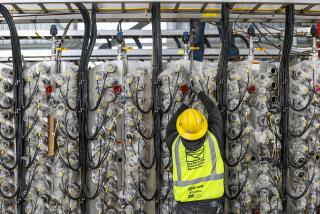Florida Agrees to Preserve Everglades From Pollution : Environment: State settles a federal lawsuit by planning to buy land near the national park to trap phosphorous that flows into ecosystem from farms.
- Share via
WASHINGTON — In a significant step toward preserving the embattled Everglades wilderness, the state of Florida Thursday agreed to end water pollution created by the release of phosphorous from adjacent farms by the year 2002.
In the settlement of a 2 1/2-year-old lawsuit filed by the U.S. Justice Department, Gov. Lawton Chiles and Atty. Gen. Dick Thornburgh concluded a fight that had cost the state $6 million. The suit charged that phosphorous from sod farms, vegetable and sugar cane fields was causing deterioration of the delicate ecology of the Everglades National Park on the southern tip of Florida and the Loxahatchee National Wildlife Refuge, located north of the park.
Under the agreement announced Wednesday, the state will acquire some 37,000 acres of land adjacent to the Everglades and create a natural filter to remove the phosphorous that has been upsetting the balance of the vast freshwater ecosystem with its hundreds of species of plants and animals found nowhere else in the United States.
“We’ve always said we’re going to say not who was responsible first, but what steps we can take to save the park,” Chiles told a press conference at West Palm Beach as he and Thornburgh announced the settlement. “We’re not going to be spending millions of dollars litigating this.”
Chiles signaled a change in the state’s bitter denial of the federal charges of violating clean water laws two months ago when he told U.S. District Judge William M. Hoeveler at a pretrial hearing that he was prepared to “surrender” and wanted Florida to “clean up the battlefield.”
The phosphorous problem originates on thousands of acres of land adjacent to the marsh that are dry enough to be claimed for agricultural use. When the marsh grasses and plants are removed, the phosphorous, which was laid down in deep mud and peat over thousands of years, escapes and is washed into the park and wildlife refuge.
Under the recovery plan, the land acquired by the state will be taken out of production and returned to the wild, creating anew a natural filter for water flowing into the wilderness.
Although the agreement displeased farmers, it was hailed by environmentalists as an important step on a long road toward slowing the destruction of the Everglades.
“The problem of the Everglades transcends the issues involved in this case,” said James Webb, regional director of the Wilderness Society. “The suit wasn’t designed to solve the Everglades problem, but it is a clear advance, and it makes some significant contributions toward getting on with the broader problems.”
Under the arrangement announced by Chiles and Thornburgh, the state is to achieve an 80% reduction in the phosphorous level of water going into the Everglades by 1997.
More to Read
Sign up for Essential California
The most important California stories and recommendations in your inbox every morning.
You may occasionally receive promotional content from the Los Angeles Times.












